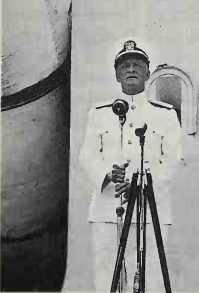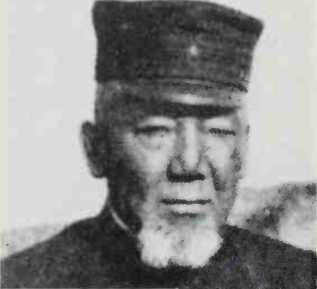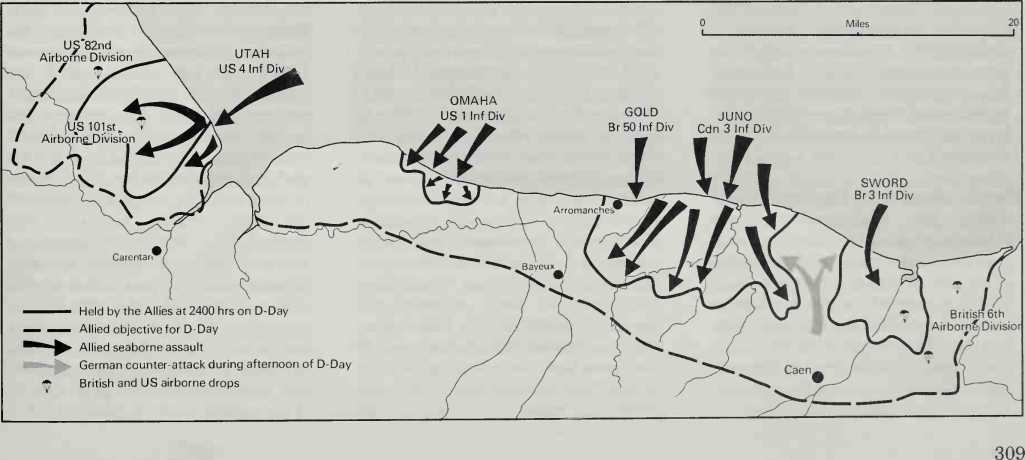Stiff resistance (about 1,400 casualties, September 17-19). British XXX Corps advanced from Eindhoven to link with 82nd Airborne early on September 19. Later that day, British Guards Armoured Division and 82nd Airborne secured Nijmegen bridge — but the delay had serious consequences at Arnhen. RO’N.

Nimitz, US Navy c-in-c. Pacific
Nimitz, Fleet Adm Chester William (1885-1966). US. c-in-c US Pacific Fleet 1941—45. On assuming command after Pearl Harbor, Nimitz faced an alarming preponderance of Japanese naval strength and badly damaged morale in the surviving portions of his own. He met the situation with strategic insight unsurpassed by any other naval commander of the time and an unerring judgment of his subordinate commanders. A delicately balanced combination of patience and daring resulted in the crucial victory at Midway in June 1942, severely reducing the Japanese numerical superiority in carriers. A series of brilliant victories followed until, in October 1944, the Battle of Leyte Gulf resulted in an overwhelming victory for Nimitz’s fleets, the Seventh under Kinkaid and the Third under Halsey. Japanese losses included four aircraft carriers, three battleships, ten cruisers and eleven destroyers. The Americans lost no heavy ships and only two destroyers, one light carrier and two escort carriers and some auxiliary vessels. With overwhelming naval superiority in the Pacific, Nimitz was able to strengthen the blockade which ensured Japan’s ultimate defeat (although not the date of it, as other actions did). Unlike most of his predecessors and many of his contemporaries, Nimitz commanded from ashore but the glamour which he thus sacrificed was more than amply compensated for by the results he achieved. ANF.
Nimrod, British Aerospace (Br). Maritime reconnaissance; crew 12. Prototype flew May 23 1967; first deliveries from October 2 1969; first squadron formed mid-1970. Thirty-two aircraft converted to Nimrod MR Mark 2 from 1981. Several operated from Ascension Island during Falklands War, 1982: about 150 sorities, some up to 19 hours’ duration. Four 12,1401b (5,507kg) s. t. Rolls-Royce Spey 250 engines; max. speed 575mph (925kph); war load wide range sonobuoys. Stingray torpedo, AGM-84 Harpoon, mines, depth charges, bombs, air-surface missiles.
Ninth Air Force (US). Formed in 1942 for operations in North Africa, flying alongside 12th US Air Force and British Desert Air Force in the Tunisian campaign and against Axis shipping in the Mediterranean. Moved to Britain for “Overlord” and, with 8th USAAF, constituted the greatest instrument for total support of land operations ever seen, operating from the front line to targets deep within the Third Reich.
Ninth Army (US). Fought under command of Lt Gen William H Simpson in Northwest European campaign, 1944—45. After the Normandy landings, deployed in Brittany. In November, was advancing up to German border. When Germans attacked in Ardennes, December 1944, Ninth Army was placed under command of Montgomery’s 21st Army Group and after crossing the Rhine, March 1945, formed left wing of pincer which cut off the Ruhr. Pushing aside the collapsing German Army Group H, the Ninth advanced to the Elbe and met the Red Army on April 25 1945.
Nishizawa, Chief Warrant Officer Hiroyoshi (1920—44). “Devil” Nishizawa, a naval Mitsubishi A6M Zero pilot, was Japan’s leading ace in World War II, variously credited with 74-200 “kills” (104 seems the nearest correct figure).
Nivelle, Gen Robert (1856-1924). Fr. Commanded an artillery regiment in 1914 and distinguished himself at the Battle of the Marne, where he deployed his guns swiftly and skilfully to engage the Germans at close range. Thereafter his rise was meteoric. A firm believer in the offensive, he was promoted brigadier in October 1914, given a division early in 1915 and by December that year was in command of III Corps. In late March 1916 he was transferred to the Verdun sector, where Retain considered his tactics too costly, but Joffre was impressed by him and, on April 19, when Retain was elevated to command the Central Army Group, Nivelle took over the Second Army. In the French counterstrokes at Verdun from October to December, Ni-velle’s use of the “creeping barrage”, behind which the infantry advanced, was outstandingly successful. Now a national hero, he replaced Joffre as French c-in-c in December 1916. Allied political leaders were persuaded by Ni-velle’s eloquence and selfconfidence that his tactical formula of saturation bombardment, followed by the creeping barrage and violent infantry assaults, would achieve the long-promised decisive breakthrough in his proposed spring offensive. At the Calais Conference in February 1917, Lloyd George even tried to make Haig permanently subordinate to Nivelle. However, the disastrous failure of his April offensive on the Aisne and in Champagne provoked widespread mutinies in the French Army and Nivelle was succeeded by Retain on May 15 1917. He never again held high command. PJS.
Nixon, Gen Sir John (1857-1921). Br. Indian Army officer (Cavalry); commanded Expeditionary Force in Mesopotamia, 1915-16.
Nixon, President Richard M
(b. l913). US. Elected President of the United States partly on the strength of popular expectations that he would end American involvement in the Vietnam War. In fact, Nixon had previously defended the war on the grounds that it contained China and bought time for “free” Asian nations to develop. Upon taking office in
January 1969, however, his main aim was simply to extricate the US in circumstances that would not be construed as defeat. The strategy gi'adually worked out by Nixon and his national security adviser, Henry Kissinger, had two main components: improvement of relations with the Soviet Union and China in return for their help in extracting compromise from Hanoi and “Vietnamization”.
Nixon also exceeded previous tacit limits on the use of armed force. He authorized the secret “Menu” bombings of communist base areas in Cambodia beginning March 1969; he approved the “incursion” into Cambodia in 1970; and he supported the South Vietnamese penetration of southern Laos (Operation “Lam Son 719”) in
1971. When Hanoi refused to make concessions and launched the Easter offensive in March 1972, Nixon retaliated with the most devastating bombardment of the war and mined the North’s harbours.
The hope that spasms of force combined with his reputation for anti-communist zeal would induce Hanoi to compromise constituted Nixon’s “madman theory of war”. However, Nixon undermined the credibility of his own threat by withdrawing troops in order to maintain domestic support. Those withdrawals brought the number of US troops in South Vietnam down to 47,000 by June 1972, leaving airpower as Nixon’s only military option. His order for B-52s to bomb Hanoi and Haiphong in December 1972 (Operation “Linebacker II”) brought Hanoi back to the negotiating table but did not result in substantive change of the draft agreement. That bombing also turned opinion in Congress decisively against Nixon’s conduct of the war, and once the Paris Agreement was signed Congress began to legislate restrictions on the use of American forces, beginning with an August 15 deadline for the cessation of bombing in Cambodia. In April 1974, with renewed fighting in Vietnam, the House of Representatives rejected Nixon’s request for a $474 million increase in military aid to Saigon. The Watergate scandal then overwhelmed his administration, and on August 9 Nixon resigned, to be replaced by Gerald RFord. WST.
NKVD. Acronym from Narodnyi Kommissariat Vniutrennikh Del (People’s Commissariat of Internal Affairs), a Soviet organization with a wide range of security, intelligence and special operations tasks.
Noble, Adm Sir Percy Lockhart Harnam (1880-1955). Br. A cruiser officer during World War I, Noble commanded on the China Station, 1937—40, and in February 1941 succeeded Adm Dunbar-Nasmith as c-in-c. Western Approaches. His training and organizational skills laid the basis for the successful anti-submarine campaign pursued by his successor, Adm Horton, from November
1942. As head of the British Admiralty delegation in Washington, 1943, he was notable for his diplomatic handling of Anglo-US naval cooperation.

Nogi: embodiment of Samurai virtues
Nogi, Gen Count Maresuke
(1849-1912). Jap. In Japan, Nogi was long regarded as the embodiment of all the traditional bushido virtues of the samurai, and the suicidal gallantry displayed by Japanese servicemen in World War II owed much to his example. He proved outstandingly successful in transmitting the values of absolute loyalty and unquestioning self-sacrifice to the men under his command during the Russo-Japanese War. Commanding Third Army, Nogi conducted the siege of Port Arthur (which he himself had taken from the Chinese in 1894) with utter ruthlessness, flinging his men in human waves against field fortifications strengthened by barbed wire, well-sited machine guns and supporting artillery. In an unsuccessful frontal attack on August 19—24 1904, Nogi lost 15,000 men to the Russian’s 3,000; in the decisive assault on 203 Metre Hill, November 27-December 5 1904, some
11.000 Japanese were killed. Both
Of Nogi’s sons fell. Nogi, who believed himself permanently dishonoured after losing an imperial standard during the Satsuma Rebellion of 1877, manifested a strong death-wish: immediately
After the war he asked, and was refused. Emperor Meiji’s permission to commit suicide. In 1912, on the death of Meiji, Nogi and his wife committed suicide. RO’N.
Nomonhan incident (Khalkhin Gol), (May-August 1939). On May 11 1939, claiming territory along the Khalkhin Gol (Khalkha river). Outer Mongolia, for their puppet state of Manchukuo (Manchuria), the Japanese Kwantung Army attacked border forces of the Mongolian Republic, which invoked Soviet aid. By early August, Japanese Sixth Army deployed c75,000 men, 500 guns, 200 tanks and 500 aircraft; opposed was a combined Soviet-Mongolian force under Zhukov, with cl00,000 men,
1.000 guns, 700 tanks and armoured cars and 500 aircraft. On August 20, Zhukov launched a massive attack at Nomonhan. Japanese forward positions were plastered by Soviet bombers; the main advance was spearheaded by flame-throwing tanks; tanks, armoured cars and Mongolian horsed cavalry supported infantry in a frontal attack, while an independent tank force circled to strike at the Japanese rear. In a ten-day blitzkrieg, Zhukov drove back the Japanese into Manchuria. The Japanese admitted to 18,000 casualties; the Soviets to 9,800. The outcome of the major air battles of the campaign remains obscure: the Japanese claimed 1,260 victories for 168 losses; the Soviets claimed 660 victories and admitted 207 losses. RO’N.
Nomura, Adm Kichisaburo
(1877-1964). Japanese Foreign Minister, 1939; Ambassador to US,
1940. Attempted to improve relations, but on December 7 1941 was ordered to deliver declaration of war in Washington: circumstances resulted in delivery shortly after Pearl Harbor attack.
Non Proliferation Treaty (NPT).
In 1969 the USA, USSR, UK and most nations of the world signed a treaty to prevent the transfer of nuclear weapons from a nuclear weapons state to a non-nuclear weapons state and the making of nuclear weapons by non-nuclear weapons states. The treaty entered into force in 1970. Non-nuclear weapons states must submit all their nuclear facilities to a system of safeguards run by the International Atomic Energy Authority. These monitor that no fissile material is being diverted for illicit purposes. Not all nations have signed the npt. Of the nuclear weapon states, France and China refused to sign, although they state unilaterally that they will not transfer nuclear weapons. A number of near-nuclear states are also non-signatories, notably India (which has exploded a nuclear device), Israel ( which has not openly tested), Pakistan and South Africa. NPT cannot prevent these states or others acquiring nuclear weapons, but it does create an international consensus against proliferation and reassures many states that their neighbours do not harbour nuclear ambitions. The treaty is reviewed at five-yearly intervals. EJG.
Normandy, invasion of (1944). Planning for the opening of the long-awaited Second Front in western Europe began in earnest in April 1943 with the appointment of Lt Gen Sir Frederick Morgan as cos to the Supreme Allied
Commander, as yet unnamed. Normandy was chosen for the invasion in preference to the Pas de Calais, where the beaches were more heavily defended and German fighters in the Low Countries much nearer. Elaborate deception plans (codenamed “Fortitude”) were devised to convince the Germans that the Pas de Calais, even Scandinavia, were the real targets. In preparing for the assault, valuable lessons were learnt from the failure of the Dieppe raid in 1942. New landing craft were developed, together with a “siege-train” of armoured vehicles - nicknamed “Funnies” - adapted for specialized tasks, such as mine-clearing, bridge-laying and flame-throwing. Eisenhower was appointed Supreme Commander for the invasion - Operation “Overlord” - in December 1943, with Gen Montgomery as ground forces commander in the opening phase.
On D-Day, June 6 1944, the invasion began with airborne landings to protect the flanks - the US 1st and 82nd Airborne Divisions to the west and the British 6th Airborne Division to the east. Bad weather had delayed D-Day for 24 hours, but it also put the Germans off their guard. Heavy air and naval bombardments preceded the amphibious landings. Some 7,000 vessels were available for naval operations, codenamed “Neptune”. From 0630 hours the Allied assault divisions landed on five beaches — west to east, the US 4th Division (Utah beach), US 1st Division (Omaha), British 50th Division (Gold), Canadian 3rd Division (Juno) and British 3rd Division (Sword). Allied aircraft dominated the skies, flying over
14,000 sorties on June 6. The Americans on Omaha suffered the heaviest casualties, but the Allies had put 156,000 troops ashore.
The Allies had established a solid lodgement area 50 miles (80km) wide by June 12, and were rapidly building up their forces. Two artificial harbours - Mulberries - were constructed at Arro-manches and off Omaha beach. But a storm in the Channel (June 19-22) wrecked the latter, and badly delayed Allied operations. Progress was slow, as the thick hedgerows of the bocage favoured the German defenders, although they were never able to wrest the initiative from the Allies, who had mastery of the air. The British and Canadians had a bitter struggle to capture Caen, but this achieved Montgomery’s aim of drawing the Germans to the British sector, easing the way for the Americans in the west. St L6 fell to the Americans on July 18, and their breakout - Operation “Cobra” - began on July 25. Armoured forces raced into Brittany and turned east towards Le Mans. Hitler ordered a counterattack to cut them off at Avranches on August 7. It failed, leaving the Seventh Army trapped in a pocket as the Canadians took Falaise on August 16 and the Americans swung north to Argen-tan. When the pocket was finally closed on August 21, the Battle of Normandy was over. SB.
D-Day, June 6, 1944: the Normandy landings mark the beginning of Operation “Overlord’'





 World History
World History









